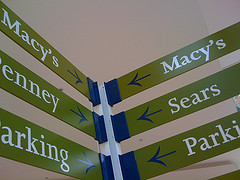What Do You Think Of The Stores-Within-Stores Trend?
These days, more and more big box and department store chains are taking a cue from shopping malls by renting out floor space to retailers to create smaller stores within stores. It’s a model that has helped some businesses to stay afloat in these tough times, but does it benefit you?
From Fortune:
Sears is carving out about 15% of the square footage its Costa Mesa, California store to house the much trendier retailer Forever 21. Target will have 1,450 Radio Shack-run mobile phone shops in its stores by the end of June. And Wal-Mart Realty says it has almost 400 in-store leases ready for some well-matched retailer who sees the benefit of letting “Wal-Mart’s repeat customers become [their] repeat customers.”…
Besides Forever 21, Sears Holding Corp worked out in-store leases with Edwin Watts Golf Shops, Work ‘N Gear, a uniform apparel store, and the Whole Foods organic grocery chain, among others. Macy’s has continued to expand relationships with partners like Sunglass Hut, Destination Modernity, and Lush, a UK toiletries concern. Bloomingdales is negotiating deals that would cede square footage to several luxury brands including Jimmy Choo, and Reiss, a hip UK-based clothier.
There are also examples like the Sephora counters inside many JC Penney stores. Even grocery stores are getting in on this idea; several Kroger outlets have Murray’s Cheese stores located within.
On a purely budgetary level, the revenue generated from the rent for these mini stores can help struggling outlets pay their own leases. For the renter of the mini-store, it can mean not having to worry about all the overhead of operating a full-size bricks-and-mortar store.
The mini stores also allow the department stores to fill in gaps in their product offerings without having to be the ones responsible for placing orders and tracking inventory.
And then there are moves that can benefit the public images of the companies involved. Of the Sears deal with Forever 21, a professor at the University of Pennsylvania tells Fortune, “Sears has a worn out, old-timer image and obviously wants to make sure young people have a chance to again see how good it is.”
Of course, one of the problems with this model is that it could potentially alienate or annoy customers.
For example, if Target puts in a RadioShack section, it needs to remove or consolidate something else to make room. Yes, Target will make guaranteed revenue from the Shack deal, but what if the store ends up losing customers who had been buying whatever products were ousted to make room for the kiosk?
And then there’s also the question of variety. Say that a department store makes a deal to rent a mini shop space to a sneaker brand. Will the department store still be allowed to sell sneakers that compete with what’s for sale in the mini store? One could easily see a situation where a mini store lessee makes non-compete or most-favored-nation agreements with its host store.
What do you think: Should department stores continue on with this trend, or is it time to slow down and give it some thought?
Stores within stores: Retail’s savior? [CNN/Fortune]
Want more consumer news? Visit our parent organization, Consumer Reports, for the latest on scams, recalls, and other consumer issues.


